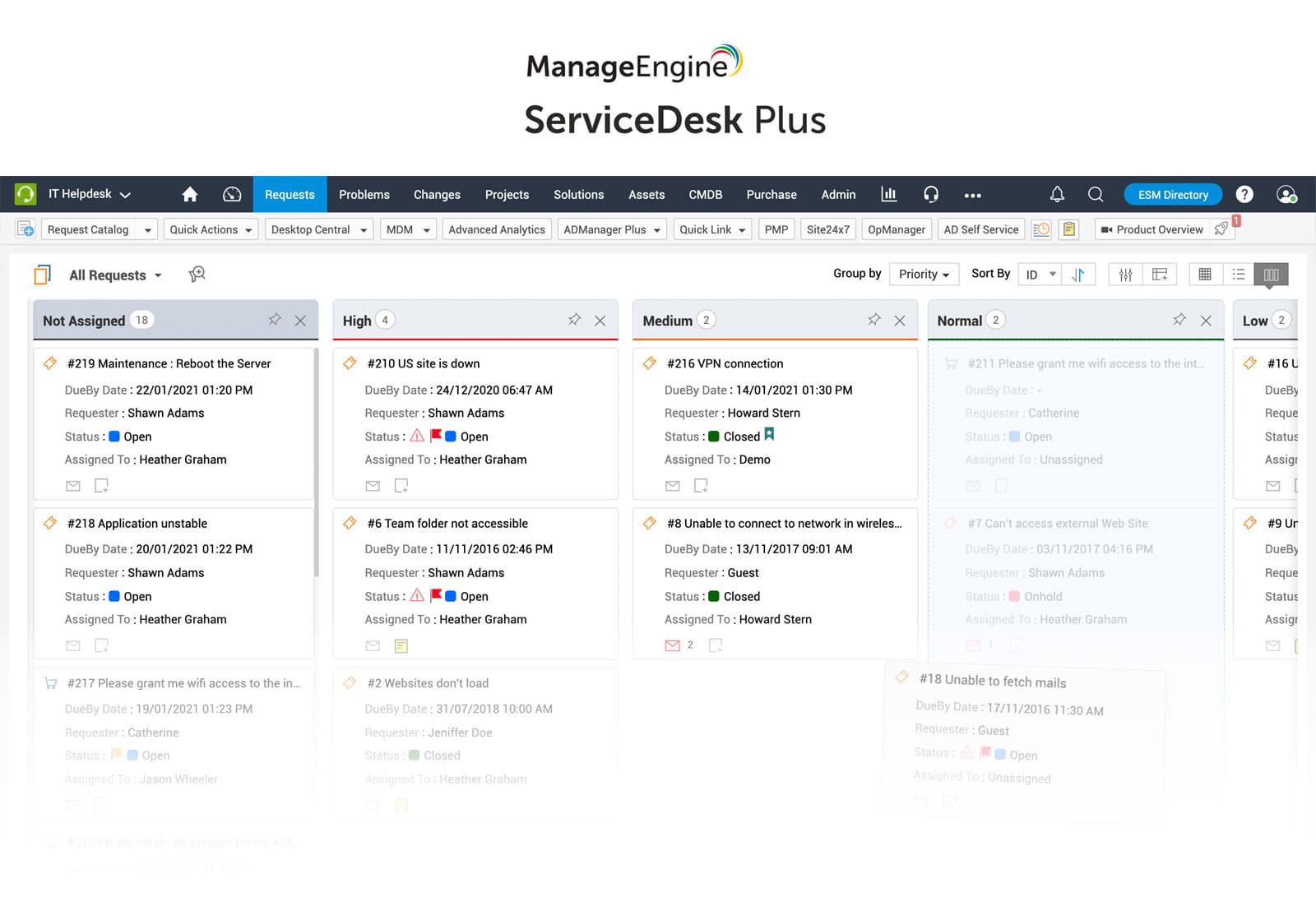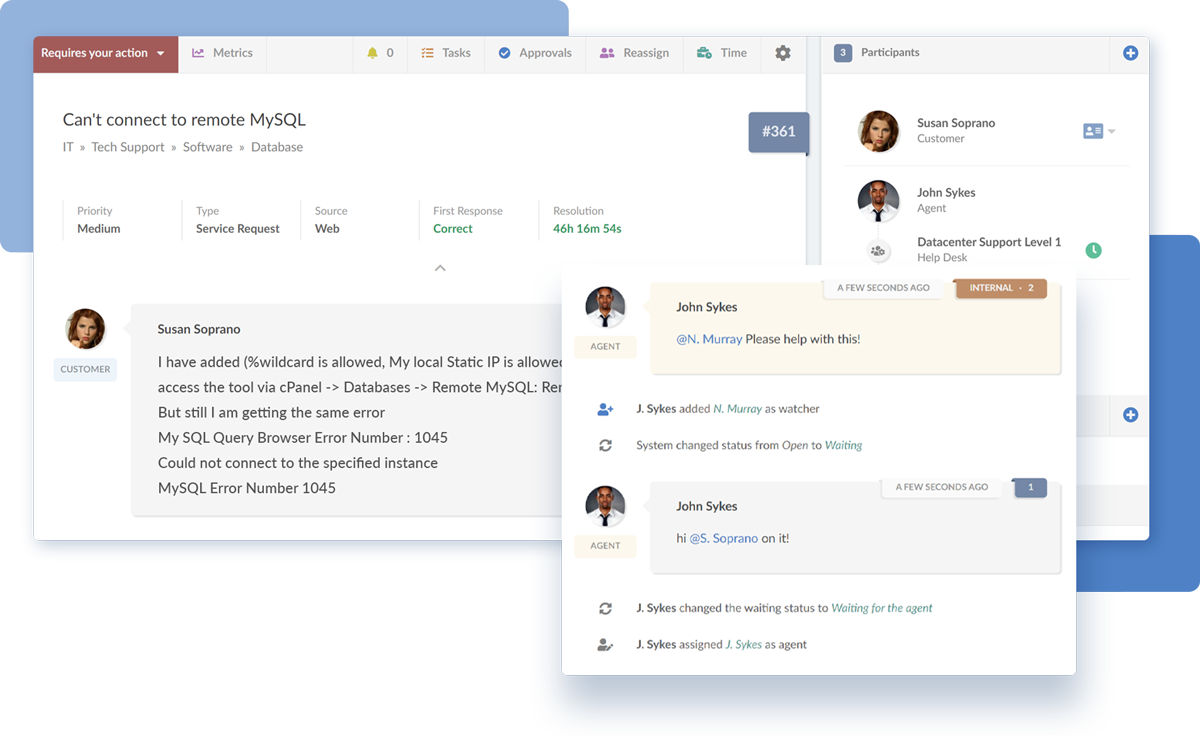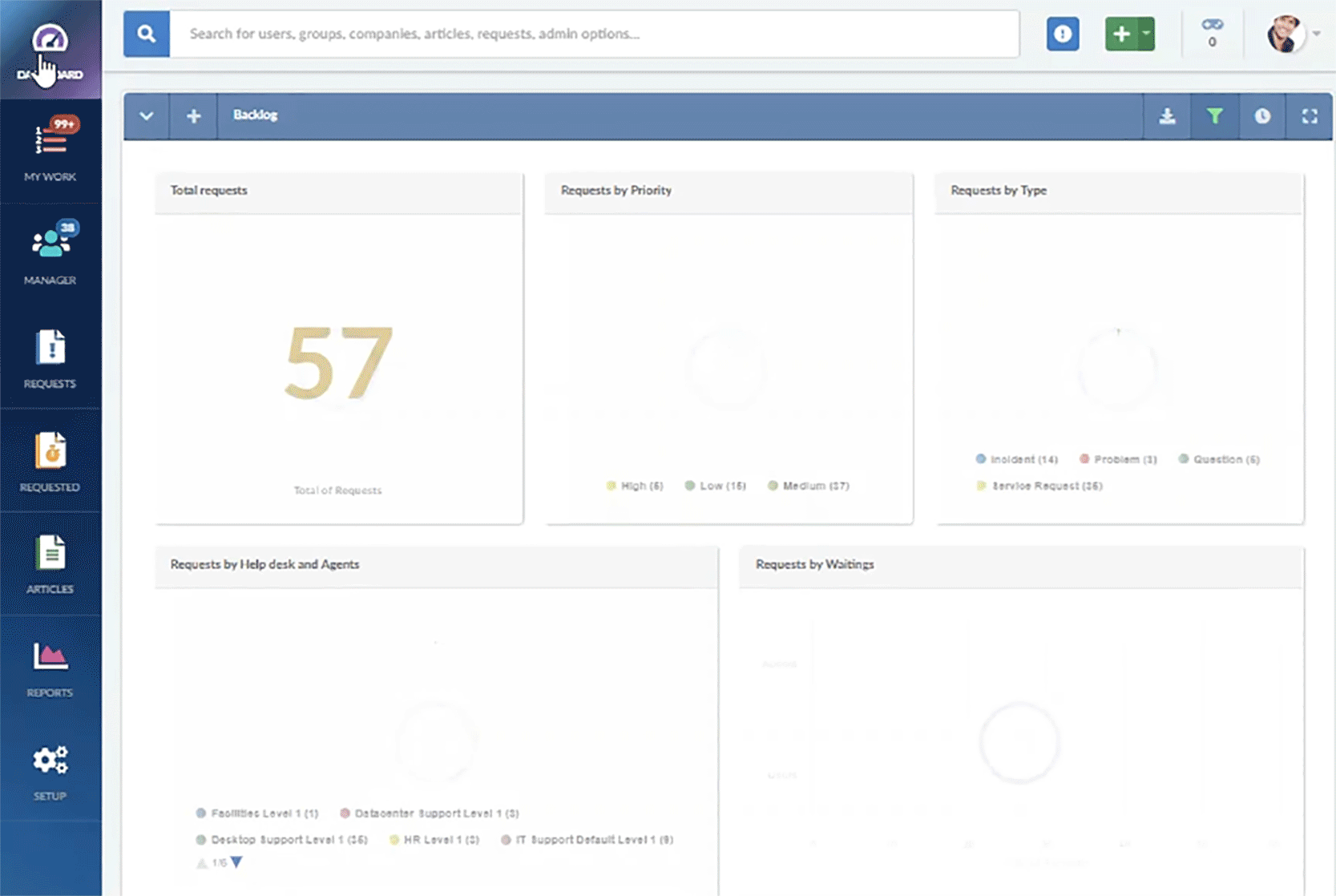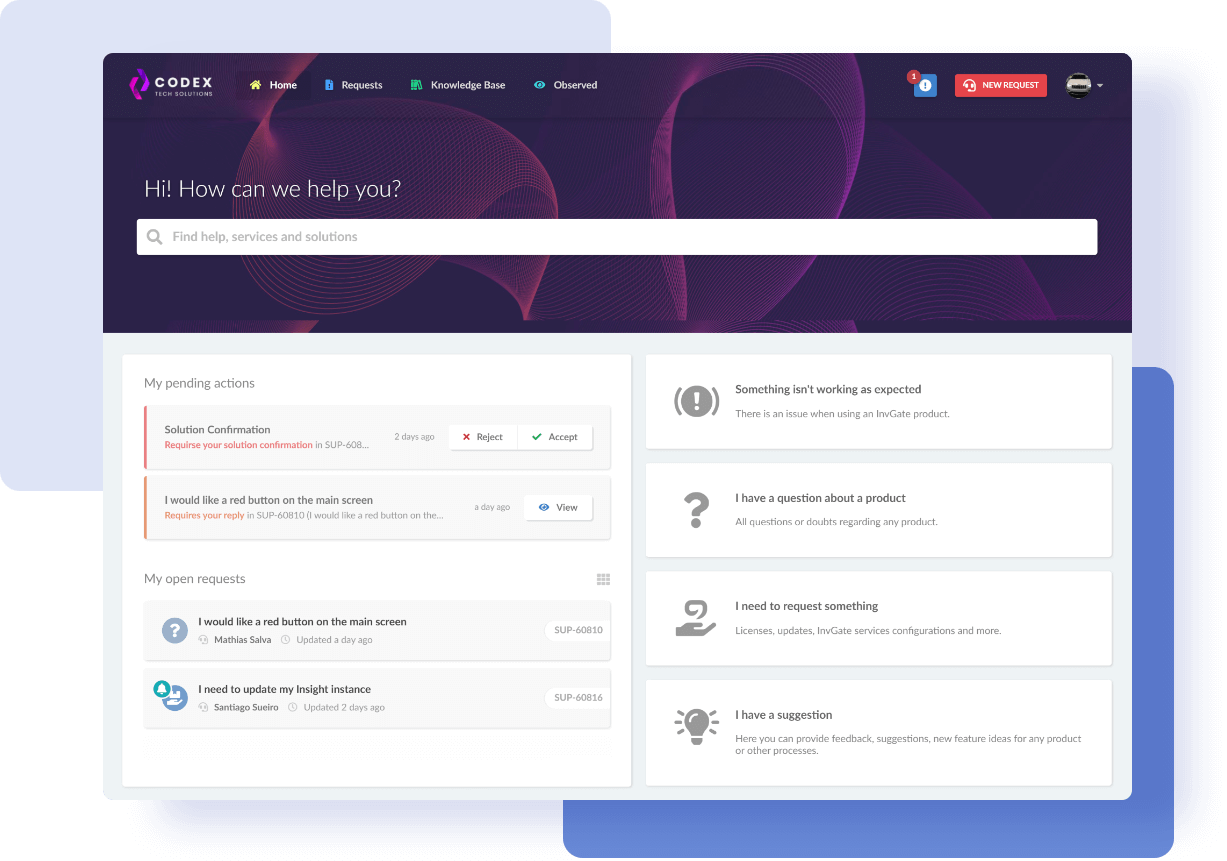Are you comparing Aranda Service Management vs. ManageEngine to transform your IT Service Management (ITSM) operations? Making the right choice can significantly impact your organization's efficiency and service delivery. With both platforms offering unique features and capabilities, conducting a thorough evaluation is essential before making a decision.
In this blog post, we'll delve into the key aspects of Aranda Service Management and ManageEngine. However, the comparisons don't end there. We'll also introduce you to an alternative solution that stands out amidst this competition: InvGate Service Management. This solution goes beyond traditional service desk software, emphasizing digital transformation, streamlined functionalities, and an opportunity to elevate your IT operations to new heights.
Let's embark on this ITSM tools comparison journey and find the perfect fit to transform your IT operations.

Table of contents
- TL;DR
- What is Aranda Service Management?
- What is ManageEngine?
- Considering InvGate Service Management as an ITSM solution alternative
TL;DR
- Aranda Service Management offers a unified web console, flexible installations, and specialized Spanish support, though lacks feedback from major review platforms.
- ManageEngine showcases strong growth and a vast IT solutions portfolio but faces concerns over 2023 security vulnerabilities and limited integrations.
- InvGate Service Management excels in ITSM with robust ticketing, user adaptability, no-code/low-code options, and dedicated support for the Spanish market, emphasizing its cost-effectiveness.
We tried to be as thorough as possible, but if you don't have enough time to read it through and through, here's (another) TL;DR: InvGate Service Management can do everything we say here, and you can test it right away for free for 30 days.
Most looked-at features by buyers
When evaluating options for IT Service Management, potential buyers focus on specific features that are suitable for their organization's needs. Understanding these desired features is crucial for making well-informed decisions.
Let's explore the key factors prospective buyers typically consider when comparing ITSM tools.
- Self-service portal and knowledge base - Buyers highly value the inclusion of a self-service portal that empowers end-users to independently resolve common issues and access relevant information without direct assistance.
- User experience and interface - Buyers prioritize user-friendly platforms with intuitive interfaces to encourage user adoption and improve productivity. Mobile accessibility is also crucial, particularly for organizations with remote or mobile workforces.
- Ticket Management solution - Buyers recognize the importance of a comprehensive system for managing customer inquiries and support requests. This feature enables efficient tracking, assignment, and resolution of tickets within help desk software.
- ITIL compliance - Many organizations prioritize solutions that adhere to ITIL best practices. Buyers may focus on solutions that support ITIL processes such as Incident Management, Problem Management, Change Management, and Asset Management.
- Support automation and Workflow Management - Buyers actively seek software solutions that offer automation capabilities to streamline routine tasks like ticket routing, approvals, and escalations. These automation features contribute to increased efficiency and productivity.
- Customization and flexibility - Buyers look for software solutions that can be customized to align with their business needs. Having flexibility in tailoring the platform to unique workflows and processes enhances user satisfaction and overall effectiveness.
- Optimized IT service catalog - Organizations often require a centralized platform for users to request specific IT services or resources. This streamlined IT service catalog simplifies service requests, improves visibility, and assists in effective service delivery management.
- Scalability - Organizations with evolving needs prioritize solutions that can adapt to their growth and accommodate customization. The software should allow the creation of custom fields, workflows, and extensions/plugins to meet unique business requirements.
- Seamless integration capabilities - Integration with other systems and applications is a critical requirement for buyers to ensure smooth data flow and process automation. The ability to integrate with existing tools (particularly ITAM tools) and platforms is highly valued for improved efficiency and a unified user experience.
- Insightful reporting - Buyers seek help desk software with robust reporting tools like dashboards and reports to gain valuable insights into their IT operations and performance. These data-driven insights facilitate informed decision-making and continuous service improvement.
- Efficient IT Asset Management - Users prioritize software that offers strong capabilities for managing IT assets, including accurate inventories and optimized resource utilization within their organizations.
- Pricing and support - Buyers consider the solution's cost-effectiveness, including licensing models, subscription plans, and additional costs for features or users. The availability of reliable customer support, comprehensive documentation, and accessible training resources also play a significant role in the decision-making process.
What is Aranda Service Management?
Aranda Service Management is the primary software solution offered by Aranda Software, a Colombian company specializing in IT services and Infrastructure Management. This comprehensive software is specifically designed to help businesses efficiently handle various processes and provide support for different types of cases. With Aranda Service Management, businesses can effectively manage requests, incidents, problems, and changes, all from a centralized console.
Apart from Aranda Service Management, Aranda Software also offers several other software products that adhere to ITIL best practices. Among these products is Aranda Asset Management, which is focused on delivering value to businesses in the Latin American region. With a strong local presence in 10 Latin American countries, Aranda Software provides flexible licensing options, including Cloud, On-premise, Hybrid, and SaaS models.
What users like from Aranda Service Management
The following advantages are derived from the company's website as of the time of writing. Unfortunately, there are no accessible reviews on popular platforms like Gartner, G2, or Capterra, which could provide additional insights from user perspectives.
- On-premise/Cloud mode - Users have the flexibility to choose from various installation options that align with their infrastructure needs and organizational preferences, whether they prefer an on-premise or cloud-based deployment.
- Design and usability - Users find the software's interface to be intuitive, with easy configuration, fast loading times, and overall user-friendliness. These factors contribute to a positive user experience.
- Unified web console - The platform provides a unified web console that can be accessed through a fully web-based platform. This integrated and centralized suite eliminates the need to install a console on individual computers.
- Rapid implementation - The platform aims to expedite the implementation process by offering default configurations, templates, and models. These resources are readily available to accelerate the configuration process and ensure a quick setup.
- Aranda Query Manager included - Users with an ADM package license can take advantage of the Aranda Query Manager feature. This advanced reporting solution offers a customizable dashboard, enhancing reporting capabilities.
- Local support in Spanish - The tool offers a specialized and certified support team available in Latin America, providing assistance to users in their preferred language.
What users don’t like from Aranda Service Management
It is challenging to pinpoint specific dislikes or criticisms regarding Aranda Service Management since there are no available reviews or feedback on platforms like Gartner, G2, or Capterra. Without user perspectives and experiences shared on these platforms, no negative aspects have been highlighted.
What’s Aranda Service Management’s argument over ManageEngine?
It can be difficult to make a definitive argument about the superiority of Aranda Service Management over the ManageEngine due to the lack of user feedback and reviews specific to Aranda. However, by examining the benefits and strengths Aranda Service Management emphasizes, here are the potential areas where it may offer distinct advantages over ManageEngine.
- Installation flexibility - Aranda Service Management offers both on-premise and cloud-based deployment options. This flexibility allows organizations to choose the installation mode that best aligns with their infrastructure needs and preferences. Whether organizations prefer to have full control over their IT environment with on-premise deployment or opt for the scalability and convenience of cloud-based deployment, Aranda provides the necessary options.
- Intuitive design and usability - The software's easy configuration, fast loading times, and user-friendly interface enhance the user experience. Aranda prioritizes a seamless and efficient user interface to ensure that organizations can effectively manage their IT service operations.
- Rapid implementation - Aranda aims to expedite the implementation process by offering default configurations, templates, and models. These readily available resources enable organizations to accelerate the configuration process and ensure a quick setup. The platform's focus on rapid implementation helps organizations save time and resources during the initial deployment phase.
- Local support in Spanish - Aranda Service Management offers specialized and certified support in Latin America, assisting users in their preferred language. This localized support ensures that organizations in Spanish-speaking regions can receive timely and relevant assistance, facilitating effective adoption and ongoing usage of the platform.
What is ManageEngine?

ManageEngine, formerly known as AdventNet Inc., went through a rebranding in 2009 and now operates under the name Zoho Corporation. ManageEngine specializes in providing comprehensive IT Management solutions for businesses of different sizes, with a focus on small to midsize enterprises.
The company is headquartered in Pleasanton, California, and has a significant global presence, serving over 180,000 customers worldwide.
One of ManageEngine's main offerings is ServiceDesk Plus, a platform that offers flexible deployment options, including both cloud-based and on-premise solutions. ServiceDesk Plus covers various capabilities related to ITSM and ITAM. In the Gartner Magic Quadrant, ManageEngine is positioned as a Challenger, indicating its competitive position in the market.
What users like from ManageEngine
ManageEngine has received recognition and positive customer feedback, as evidenced by reputable sources like Gartner. Let's explore some of the key advantages highlighted by these customers.
- Strong growth - ManageEngine demonstrates significant growth potential, as reflected in its flexible deployment models and successful position in the midmarket segment. In 2021, the company experienced notable revenue growth and expanded its customer base significantly. Its success has been particularly evident in the enterprise sector, establishing its position as a rapidly growing player in the industry.
- Wide range of products - ManageEngine offers a comprehensive portfolio of complementary products that cover various areas, including endpoint management, network monitoring, application monitoring, and active directory management solutions. With the support of its parent company, Zoho, ManageEngine leverages low-code development capabilities and line-of-business integrations to provide a broad set of platform features and deliver added value to its customers.
- Competitive pricing - ManageEngine sets itself apart through its competitive pricing strategy, offering cost-effective ITSM solutions. With multiple pricing tiers available, the platform caters to different budgets, making it an appealing choice for midmarket customers and larger organizations seeking value-driven solutions.
What users don’t like from ManageEngine
Despite having several strengths and positive aspects, ManageEngine has also received criticism and concerns from customers regarding certain aspects of the platform. These concerns have been identified by analyzing reputable sources such as Gartner. Let's explore some of the specific areas that have raised customer apprehension.
- Security vulnerabilities - In 2023, ManageEngine faced a significant setback with the discovery of two critical vulnerabilities in 24 of its products. These vulnerabilities were rated 9.8 out of 10 on the severity scale, as they had the potential to allow remote execution of malicious code. However, the company promptly addressed the situation by releasing patches to mitigate the vulnerabilities and enhance security measures.
- Limited integrations beyond Zoho Ecosystem - The platform's integrations and extensibility are strongest when combined with other ManageEngine and Zoho ecosystem products. This may pose challenges for customers who want seamless integration with popular ITOM tools outside of the Zoho ecosystem, potentially requiring them to develop custom API connections.
- Limited product innovation - ManageEngine primarily focuses on improving processes, integrations, and customization support rather than pushing the boundaries of product innovation. While the company has incorporated some AI/ML capabilities in areas such as field and template recommendations, it still lags behind more advanced products in this category.
- Unclear differentiation in ITSM marketing - ManageEngine's marketing efforts often fail to highlight its unique value proposition in the ITSM market effectively. By primarily focusing on common themes like low-code development, customer privacy, and deployment flexibility, the company struggles to stand out among more experienced buyers in the market.
What’s ManageEngine’s argument over Aranda Service Management?
ManageEngine, as a competitor to Aranda Service Management, presents several arguments to position itself as a strong alternative. Let's explore some of the key points of differentiation.
- Strong growth and market presence - ManageEngine has experienced significant growth, expanding its customer base and revenue. This growth is attributed to its flexible deployment models and success in the midmarket segment. The company's success in the enterprise sector further reinforces its position as a rapidly growing player in the ITSM market.
- Wide range of products - ManageEngine offers a comprehensive portfolio of complementary products that cover various areas, including endpoint management, network monitoring, application monitoring, and active directory management solutions. This breadth of offerings allows customers to address multiple IT management needs through a single vendor, promoting efficiency and integration.
- Competitive pricing - ManageEngine differentiates itself through its competitive pricing strategy. With multiple pricing tiers available, the platform caters to different budgets, making it an appealing choice for midmarket customers and larger organizations seeking cost-effective ITSM solutions.
Considering InvGate Service Management as an ITSM solution alternative

In the competitive world of IT Service Management, Aranda Service Management and ManageEngine stand out as recognized competitors. However, it is crucial to explore alternative solutions that closely align with the unique needs of your organization. In this regard, InvGate Service Management emerges as a compelling choice that warrants careful consideration. Let's now delve into the extensive features of InvGate Service Management that make it a valuable option for meeting your organization's ITSM requirements.
Exceptional user experience
InvGate Service Management places a strong emphasis on delivering an exceptional user experience through meticulous design and adherence to UI/UX best practices. Its intuitive interface promotes quick adoption, minimizes the need for extensive training, and ensures a user-friendly design that maximizes productivity.
Robust Ticketing and Incident Management

InvGate Service Management offers powerful features that enable efficient tracking, collaboration, and resolution of tickets. It includes automated ticket routing, customizable workflows, and SLA Management, empowering IT teams to handle and prioritize incidents effectively.
Comprehensive reporting and analytics

InvGate Service Management provides extensive reporting and analytics functionalities, empowering organizations to gain valuable insights into their IT operations and performance. The platform offers ready-to-use reports and customizable dashboards, enabling IT teams to analyze data, identify patterns, and make informed decisions to enhance their services.
Simplified configuration and setup
InvGate Service Management simplifies the configuration and setup process with a user-friendly, no-code/low-code approach. This allows both novice and experienced users to implement the system without extensive technical expertise. The platform offers straightforward configuration options, enabling organizations to leverage its powerful ITSM capabilities quickly.
Customization and flexibility
InvGate Service Management offers flexible deployment options, allowing organizations to choose between on-premise or cloud-based solutions. This adaptability ensures that the platform can cater to the specific requirements of different sectors and industries.
Strong self-service capabilities

InvGate Service Management provides robust self-service functionalities, such as a user-friendly portal, an extensive IT service catalog, and a knowledge base. These features empower end-users to independently resolve common issues, access various IT services, and utilize self-help resources, thereby reducing the workload on IT staff.
Comprehensive Asset Management
Integrating InvGate Service Management with InvGate Asset Management provides organizations with a holistic view of their IT ecosystem, leading to improved service delivery and reduced downtime. InvGate Asset Management offers features such as IT Asset Discovery, Inventory Management, Software License Management, and maintenance schedules.
Cost-effective solution
InvGate Service Management provides a cost-effective solution without compromising functionality. It offers a comprehensive range of ITSM features at a competitive price, making it an appealing choice for organizations seeking affordability without sacrificing capabilities. Compared to alternatives like Aranda Service Management and ManageEngine, InvGate Service Management strikes a balance between cost and functionality.
ITIL-certified readiness
InvGate Service Management has achieved the prestigious ITIL4 certification from PINK Elephant, demonstrating its commitment to upholding ITSM excellence. Whether organizations are starting their ITIL journey or managing complex operations, InvGate Service Management provides a user-friendly and feature-rich experience aligned with industry best practices.
Focused on ITSM with ESM extension
InvGate Service Management is purpose-built for ITSM and seamlessly extends its capabilities to Enterprise Service Management (ESM). This allows operational departments to improve their processes and fully embrace the benefits of digital transformation. With a primary focus on ITSM and strong performance in ESM, InvGate Service Management facilitates streamlined workflows and comprehensive digital transformation initiatives across all departments.
Fast ROI and ongoing innovation
InvGate Service Management ensures a rapid return on investment through efficient implementation processes. Within weeks, organizations can begin experiencing the benefits of this robust ITSM solution. Additionally, regular feature updates keep users at the forefront of technology without incurring additional costs.
Next steps
When evaluating Aranda Service Management vs. ManageEngine, both platforms exhibit strengths and advantages that organizations should consider based on their unique requirements.
Additionally, exploring alternatives beyond Aranda and ManageEngine is advisable to ensure a comprehensive evaluation. One such alternative that deserves attention is InvGate Service Management. With its focus on delivering an exceptional user experience and robust functionalities, InvGate Service Management presents a compelling choice for organizations aiming to optimize their ITSM operations.
Ready to explore how InvGate Service Management can benefit your organization? Request 30-day trial for a hands-on experience!
















